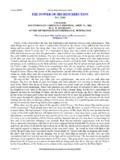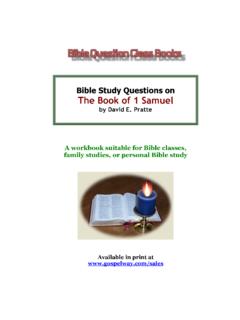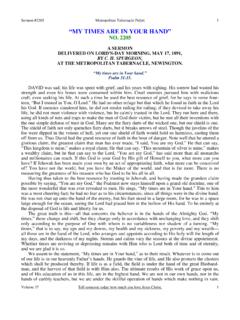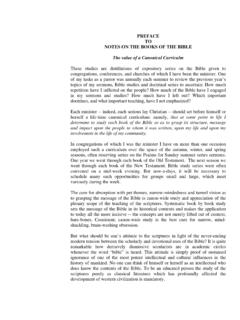Transcription of Rod of An Almond Tree - Beauties of the Truth
1 Volume 1, Number 1, November 1980_____Rod of An Almond TreeThe Dragon of Revelation 20"7 Times" - 4 TimesWar in the Middle East!Coup in Turkey!_____Rod of An Almond tree "Jeremiah, what seest thou? .. I see a rod of an Almond tree .. Thou hast well seen: for I willhasten my word to perform it." JEREMIAH 1: 11, 12 What does an Almond rod have to do with the Lord "hastening" to fulfill his word? It isevidently a play on words in the Hebrew. In Nelson edition of the American Standard Version thefootnote gives shaked for " Almond tree ," and shoked for "hasten" (rather, "watch" in ASV). (Footnote - How is it that the two words are so similar? Rotherham's footnote: "'The watcher' -'so called from its early blossom, as being the first of the trees to wake from the sleep of winter.'-Davis' " His translation is "a twig of an Almond tree .. Thou hast rightly seen, for keepingwatch am I, over my word to perform it.)
2 ") The use of sound-alike words to emphasize a point appears also in Isaiah 5: 7. In Rotherham'stranslation, "And he waited for equity but lo! murderous iniquity. For the rule of right, but lo! Thecry of the wronged." His footnote: " : the striking assonance-'And he waited for mishpat, but lomispah; for zedhakah, but lo zeakah.'" But there is a notable difference between the word play of Jeremiah and that of Isaiah. In Isaiahthe meaning of the words convey a direct thought, in addition to the "assonance," In Jeremiah, thereappears to be little direct relation between an Almond tree and the accomplishment of God's word. Symbolically, however, there is a connection. The rod of an Almond tree represents themanifestation of God's election of the Church class. This comes from its use in the Tabernacle toshow that Aaron and his tribe were to serve the priestly and ceremonial duties.
3 (Numbers 17) Arepresentative of each tribe provided a rod; these were collectively laid up in the tabernacle byMoses. "And it came to pass, that on the morrow Moses went into the tabernacle of witness; and,behold, the rod of Aaron for the house of Levi was budded, and brought forth buds, and bloomedblossoms, and yielded almonds. And Moses brought out all the rods from before the Lord unto allthe children of Israel: and they looked, and took every man his rod. And the Lord said unto Moses,Bring Aaron's rod again before the testimony, to be kept for a token against the rebels .. " But what particular manifestation of God's election of the church is represented in Jeremiah 1:11? We think it is the resurrection of the sleeping saints, (Footnote - The other possibility whichcomes to mind is the completion of the church in glory. But against this is that Jeremiah representsthe harvest saints in the flesh.)
4 Investing them with judicial authority and power (Rev. 11: 15) toactually accomplish the words of Jeremiah 1: 10 -" .. over the nations and over the kingdoms, to root out, and to pull down, and to, destroyand to throw down, [and, concerning Christ's kingdom] to build, and to plant." Jeremiah, who spoke these words, pictures the saints in the flesh. They are God's spokesmendeclaring the necessary replacement of present institutions with the incoming Kingdom of Christ. Our mouths have been "touched" and the Lord says to us "I have put my words in thy mouth."(vs. 9) (Notice a similar mention respecting Isaiah who had his mouth purged to cleanse him forservice-another picture of the saints in the 6: 5-7) Among other scriptures which show a close relationship between the raising of the saints and thejudgments of Christendom, note Obadiah 21, and Ezek.
5 43: 2, 4, 5 cf. Rev. 18: 1, Dragon of Revelation 20 As there appears to be some question regarding the identity of the dragon of Revelation 20, thefollowing is offered as a summary of the position that it represents primarily the civil power as atool of the adversary. Dragon appears in the New Testament only in the book of Revelation. There it appears only inchapters 12, 13, 16 and 20. The 12th chapter is explained in detail by Bro. Russell in which heclearly shows the dragon as pagan Rome as the enemy of both the true and the apostate is not an unsafe generalization to say that in this chapter Bro. Russell equates the dragon withcivil power . In the 13th chapter he does likewise, and in the 16th chapter likewise. It should not,therefore, be inconsistent or surprising to claim that the final mention of the dragon in Rev. 20 isalso representative of civil power .
6 Some, however, seriously questions this position. On R4609 Bro. Russell stresses that while the devil of Rev. 20 includes the actual being (thepersonal devil), the term is much broader than that and represents a system. Care must be takenwith this quote. Note that Bro. Russell says "religious system." Note also that he specifies verses7-9 dealing with war in heaven. Because the dragon was pagan it was religious in a pagan senseonly. But as such it did control the heaven of its day. The result of the battle, however, is that thedragon is cast out of heaven to which it never returns. After this point it is an exclusively civilentity-a thought which we believe is consistent with all of Bro. Russell's writings on the matter andwhich accounts for his interpretation of dragon in chapters 13 and 16. The internal evidence from the book of Revelation seems to support the conclusion that thedragon of chapter 20 is the civil power heretofore discussed.
7 We believe this evidence is strongestin the following three references: 1. In Revelation 12: 9 this dragon is named with its multiple names: dragon, serpent, devil andSatan. Only in one other place does this occur: Rev. 20: 2. It is not unreasonable to think that thisis so because the Lord wished to stress to the careful observer that the identity of the entity in : 2 is the same as that which was cast out of heaven in Rev. 12: 9 - , the civil power . 2. In Rev. 16: 13 is introduced a trinity of enemies: beast, dragon, and false prophet. TheRevelator follows these enemies until their destruction. Two of them, the beast and false prophet,are destroyed in the lake of fire in 19: 20. But the dragon is not. Thus the 20th chapter is set asideas a detailed description of the destruction of the same dragon introduced in 16: 13 - the civilpower.
8 Some have suggested that the dragon is represented in chapter 19:19 under the words "kings ofthe earth." We do not believe this to be true because "kings of the earth" are also listed in 16:14 asthe ones affected by the pronouncements issuing from beast, dragon, and false prophet. Therefore,a distinction must be made between dragon and kings of the earth. They are not the , note that the kings of the earth are not destroyed in the lake of fire in 19:20 with thebeast and false prophet so that if the kings of the earth were synonymous with the dragon, theirdestruction would even so of necessity be reserved for a later text than chapter 19. 3. Rev. 20:10 shows us that finally, at the end of the little season, the dragon has joined the beastand false prophet in the lake of fire. There would be no need to mention the beast and false prophetin this verse except to draw our attention to the fact that all three enemies of 16:13 are finallyaccounted for-the third having its demise 1000 years later than the first two-and its identity yet thesame: civil power .
9 In summary it would be wise to stress again that the personal devil must not be excluded fromRev. 20. His personal binding as shown by Jesus in the Gospels is to be an accomplished , chapter 20 is not primarily dealing with the personal devil, but rather with the bindingand ultimate destruction of his long-cherished tool: civil government. It seems to have been ourPastor's expectation that the deception of the little season would be in the form of a civilgovernment- a coup to displace or challenge the ancient worthies. This concept is in harmony withthe loosing of civil government and its master, Satan. Perhaps the terms Gog and Magog also giveus the same clue. These names in the gospel harvest we do not connect with a religious power norwith the personal devil solely, but rather with some civil invading force. A similar interpretation atthe little season is consistent.
10 In short, there seems to be no particular argument against the dragon of Rev. 20 beingrepresentative of civil power , and there seems to be strong, consistent, contextual argument for the Lord enlighten us further as need Contributed"7 Times" - 4 Times "Hew down the tree .. leave the stump of his roots in the earth, even with a band of iron andbrass .. let a beast's heart be given unto him; and let seven times pass over him" - Daniel 4:14-16 This text comes from a dream of Nebuchadnezzar, king of Babylon. Many things occur indreams which are impossible in reality. That was true in this dream. Nebuchadnezzar saw a greattree which sheltered and nourished all the beasts of earth and fowl of heaven. "The height thereofreached unto heaven, and the sight thereof to the end of all the earth." Suddenly this majestic treewas ordered of the angels to be hewn down, but to leave the "stump of his roots in the earth.








